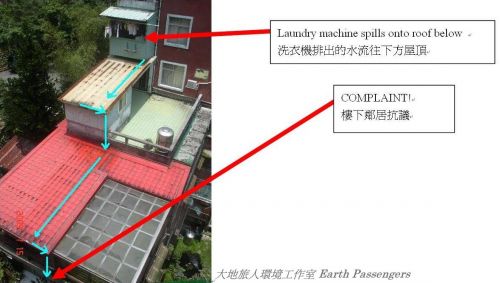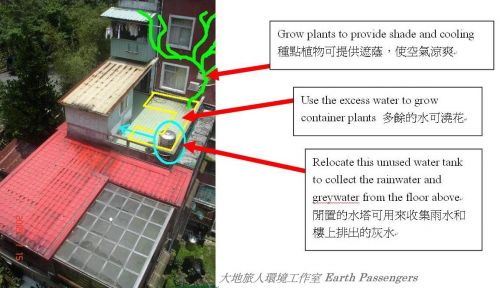- 社區
- 2020分享會。樸門人物。游原嵩。
- 2020分享會。樸門人物。呂燕華。
- 2020分享會。樸門人物。蔡雪青。
- 2010年10月23日台灣樸門永續設計學會案例分享會
- 璟蓉的學習筆記-種樹豆
- 兼顧社會關係的樸門永續設計 Configuring Social Relations into Permaculture Design
- 樸門永續設計2009年七月讀書會:微氣候/Permaculture Study Group June 2009: Microclimates
- Permaculture樸門永續設計倫理與原則的應用(1)
- Permaculture週記 by 第一屆PDC畢業生震洋
- 幸福徵文by震洋
- 幸福徵文by泰迪
- 幸福徵文-而從此之後,所畫的每一棵樹,都有了根~~~
- 都會空間
- 學校
- 農場
兼顧社會關係的樸門永續設計 Configuring Social Relations into Permaculture Design
Configuring Social Relations into Permaculture Design
台灣樸門永續設計學會 創始首屆理事長 、現任第三屆常務監事 孟磊
by First Director, Taiwan Permaculture Insititute,
Current Standing Supervisor , Peter Morehead
樸門永續設計師的工作當中,有一大部分會涉及到社會與文化關係。我在台東的地位於阿美族的聚落居,最近在研究阿美文化的時候,突然有了這層體會,便想運用阿美文化的內涵,進一步發展並重建樸門永續設計解決現今環境問題的能力。我用「重建」(reinstitute)一詞,是因為我深信阿美族在數世紀以前,已經達到樸門設計所追求的境界:尊重大地的各種先天限制。當我目睹耆老在各種不同條件的自然環境當中生存,包括在產季捕撈沿岸海產、上山打獵並收割農作物時,又再度確認了這點。這種可持續的文化在制式的教育體系建立之後慢慢喪失,後來又受到農藥發明、酒精入侵部落和高速公路開通這三重致命的打擊。阿美族每個月至少會損失一名耆老,跟前面三項因素的出現大有關係。以可怕的除草劑巴拉刈為例,這種毒藥已經在世界各地,包括日本、巴布亞紐幾內亞、哥斯大黎加等國,造成上千名意外死亡、自殺和生病的案例。
Much of the work of permaculture designers heavily implicates social and cultural relations. This fact has recently hit home for me as I delve into the Amis culture of our land in Taidong. I am very interested in working with the Amis culture to develop and reinstitute permaculture solutions to current problems. I say “reinstitute,” because I firmly believe that a few centuries ago the Amis culture had already achieved a permaculture that respected the natural limitations of the land. This is reconfirmed when I see elders working across a diverse spectrum to harvest coastal seafood, mountain game, and agricultural crops. Much of this permaculture has been lost mainly due to introduction of institutionalized education, along with the deadly three: pesticides, alcohol, and high-speed roadways, which combined are responsible for killing at least one Amis elder per month. One of the herbicidal culprits is Paraquat, a poison responsible for hundreds of accidental deaths, suicides and illnesses annually in Japan, Papua New Guinea, Costa Rica and other nations around the globe.
巴拉刈因為毒性強大,會傷害兩棲生物、水生動物和鳴鳥類,已經被芬蘭、瑞典和奧地利等國明令禁止,不過在台灣是非常普遍,幾乎每個月都會噴灑的除草劑。在很多貧窮的國度,因為巴拉刈價格低廉,常是負債累累的農夫用來結束生命的自殺工具。上個月,住在都蘭北邊興昌部落的一位原住民鄰居就吞下一整瓶的巴拉刈企圖「解決」債務問題,好在及時被附近的朋友發現他「僵硬、嘔吐、眼神可怖」地倒在地上,趕緊送醫急救並催吐,才不致喪命。屬於四氮系類的巴拉刈常用來清除寬葉雜草,藥效發揮快,並不會選擇性地除去特定植物,接觸植物時會破壞植物的組織,也會滲入植物內部進行破壞工作。巴拉刈被人吞服之後,會先灼傷口腔、喉嚨,消化道被刺激後會出現腹痛、無食慾、噁心、嘔吐與下痢等症狀。其它的中毒反應包括口乾舌燥、呼吸短促、心跳加速、腎衰竭、肺部疼痛與肝臟受損。很多人都因此而致病,甚至死亡。
Paraquat, an herbicide banned in Finland, Sweden and Austria due to its high toxicity to amphibians, aquatic animals and songbirds, is prevalent in Taiwan and widely used on a monthly basis to kill weeds. In many poor countries, Paraquat is also a cheap and common suicide potion for farmers who are deep into debt. Just last month one of my indigenous neighbors in Singchang drank a bottle of Paraquat to “solve” his debt problems. Luckily, a neighbor found him lying “stiff, puking, and with an evil look in his eyes” just in time to rush him to the hospital and pump his stomach of this deadly poison. Paraquat is a quaternary nitrogen herbicide widely used for broadleaf weed control. It is a quick-acting, nonselective compound that destroys green plant tissue on contact and by translocation within the plant. If swallowed, burning of the mouth and throat often occurs, followed by gastrointestinal tract irritation, resulting in abdominal pain, loss of appetite, nausea, vomiting, and diarrhea. Other toxic effects include thirst, shortness of breath, rapid heart rate, kidney failure, lung sores, and liver injury. Many cases of illness and/or death have been reported in humans.

這些散落在我的農地上的殺蟲劑包裝袋,顯示附近有人在用。關於這個現象,我還在學習用溝通和建立互信的方式,來回應鄰居們的行動。
These pesticide packages were strewn on my land giving an indication of some of the toxic warfare going on in my neighborhood. I’m learning that the only useful response is communication and gradual trust-building with neighbors.
 我在2008年12月來到我在台東的地,發現地界上剛被噴了巴拉刈,我那塊地上也有被犁過的痕跡,留下的凹槽之深,在八個月後,碰到下雨還會積水。鄰居還說他幫我們犁田是免費服務…
我在2008年12月來到我在台東的地,發現地界上剛被噴了巴拉刈,我那塊地上也有被犁過的痕跡,留下的凹槽之深,在八個月後,碰到下雨還會積水。鄰居還說他幫我們犁田是免費服務…
In December 2008, I arrived at our land to find the borders recently sprayed with Paraquat, and our land itself plowed and packed into ruts that 8 months later still pond with water after a rain. The neighbor said he was doing us a service by tilling our land for free...
雖然巴拉刈和其它除草劑的害處不可勝數,但農藥已經是農耕文化的一部分,連農藥發明以前就知道用其它有效途徑控制雜草生長的原住民,也對除草劑的使用習以為常。一位當地耆老曾經邀請我去參觀他的有機菜園,等我去了之後再跟讀者分享。很不幸地,政府數十年來推廣農藥的政策,取代了所有的有機技術,讓多數老一輩的阿美族人相信使用巴拉刈和其它除草劑才是正確的農耕法。我們應該縮小這個特殊的環境-文化認知差距,讓老一輩的族人對傳統農耕技巧重拾信心,並瞭解這對環境和原住民文化將帶來長遠的好處。但是要消除這個認知差距必須先克服許多質疑與不信任。這項工作並不容易,我當初草率行事便證實了這一點。剛發現自己的地被別人噴藥時,我很生氣地去找那名鄰居理論,要他別在我的地上噴巴拉刈,結果他吐了一口鮮血般的檳榔汁在我的靴子上,這個回應反倒讓我不知所措。這名年事已高的阿美族鄰居最後還辯說:「反正我們早晚都要死,要死早就死了。」這件事讓我去不得不去破除許多情感與文化上的慣性,也更想找出一個各方均能接受,也兼顧文化面的解決途徑。
Despite the shortcomings of Paraquat and other herbicides, their use has become a part of the farming culture, even of indigenous peoples who definitely had other successful methods before this herbicide came along. One “Vagee” (elder) invited me to check out his organic vegetable patch, which I intend to do and include in a future article. Unfortunately, decades of government promotion of pesticides has changed all organic methods, and most Amis elders are convinced that using Paraquat and other herbicides is the way to farm. This is a strange environmental-cultural gap to bridge – trying to re-convince elders that their traditional way of farming is better for the environment and for their culture in the long-run. It is a tricky bridge to build, and there is much suspicion and disbelief to overcome. My first brash attempt attested to this: my first reaction was to get emotional and demand my neighbor to stop spraying Paraquat on my land. His first reaction set me in my place – a spit of betelnut blood on my boots. In the end, the farmer, an Amis elder, reacted defensively and negatively saying, “we’re all gonna die sometime anyway, so there’s nothing bad about pesticides.” The situation required me to overcome many emotional and cultural ruts and become more determined to find a culturally sensitive solution that all sides can accept.
之後我便試著不隨便動氣,而去瞭解鄰居們努力維生的處境。我不能要求他們為了我而放棄他們習用的方式。但我希望有技巧地讓他們知道巴拉刈的害處,另一方面也盡量做他們的好鄰居,在他們還沒來噴藥之前,先努力把土地交界處的草除掉。我打算買一台瓦斯割草機,在與鄰地交界處把雜草除乾淨。這個嘗試並不是最符合環保原則,但至少在文化上可以被接受的,我希望它是有效的。從事有機種植的耆老說得好,「敦親睦鄰,維持良好的人際關係是最重要的。沒有這個東西,我們的生活會變成什麼樣呢?」
My next step is to slow down on the emotional reaction and become more in tune with how my neighbors strive to make a living. I can’t expect them to stop their ways for me. I hope to tactfully spread more information on the detrimental impacts of Paraquat, but in the meantime, I will strive to be a good neighbor by cutting the weeds on our border by hand before my neighbor feels the need to spray. I will also invest in a gas-powered weed cutter to cut weeds on all the other lands bordering our property. Hopefully, this effort will prove effective, maybe not environmentally, but at least culturally. Like the organic grower Vagee said, “the most important thing that gets us through in the long run is good interpersonal relations – we have to be on good terms with our neighbors – otherwise what kind of life will we have?”
都市的文化矛盾 Cultural dilemmas back in the city
從台東回到台北,如同進入另一個國度,光是這點就可能是強大的文化震撼。都市人的生活型態多集中在小地區,公寓內的活動,跟公寓外的大環境文化並沒有什麼關聯 (我們也藉此來說服自己)。
- 都市文化跟我的阿美族鄰人就很不同,部落的鄰居覺得自行走進我的屋裏,在走廊上社交起來,是天經地義的事。也許他們發現我的屋前有一些吸引他們的地方,比如很空曠、很開放,有助於讓大家盡情討論有關影響大環境的議題。
- 我的阿美族鄰人總是在做跟土地有關的活動,這也跟都市文化很不同。在某個收成季,有個因為喝醉而暢所欲言的鄰居,便用嚴肅的口吻告訴我,他秉持的價值觀就是「地是我的命!」
我對我的地也有同樣的感覺。每次我踏上這塊土地,就好像進入廟堂之上,心中充滿敬畏之情。可是都市的問題一再地把我拉回來,因為都市的環境問題更加需要解決之道。
Coming back to Taipei from Taidong can be an intense cultural shock. Really two different countries altogether. The life of the city-dweller is territorially focused, and whatever goes on within the boundaries of the apartment walls has nothing to do with the larger culture (or so we lead ourselves to believe).
- This is unlike my Amis neighbors who find it natural to walk right into my house and use my porch for their social activities. Perhaps they have something right there, as such openness can lead to friendly discussion on activities that may affect the environment at large.
- It is also unlike my Amis neighbors connected to land-based activities; during the harvest festival one neighbor got sufficiently drunk and uninhibited to tell me in a very serious and concerned tone his heartfelt philosophy that, “my land is my life.”
I feel the same way about my land, which I enter each time in awe as if it were a temple, but the problems of the city always draw me back to an environment that seems to be in even greater need of solutions…
從我在台北的家往窗外看,可以找到一個範例,讓我們看到以樸門設計原則解決一個不是很複雜,但具有文化和自然意涵的問題。照片最上方的公寓住戶,在陽台上用洗衣機洗衣服,排出的水會從陽台溢出,流往下方住戶的陽台上。下方住戶提出抗議,社區管委會便來這裏看要如何解決。從樸門設計的角度來看,可解決的方法太多了! 如果請你來想辦法,你會怎麼做呢?
An exemplary situation just now appeared before my eyes as I looked out my Taipei apartment window. It’s a good example that describes the cultural and physical complications involved in using permaculture principles to solve a relatively simple problem. The apartment on the top of the photo does its laundry on the balcony. Excess water from the washing machine spills off of the balcony onto the rooftops below and finally onto someone’s balcony down below. The person down below has issued a complaint and the neighborhood management association has arrived today to see what can be done. From a permaculture aspect, solutions are abound! How would you solve such a problem in your neighborhood?

若把問題看成正面的資源(樸門設計原則之一),那麼辦法就多了。這項原則提醒我們,把多餘的東西視為物資。在這個例子裏,沒被善用的物資就是洗衣機所產生的灰水,那要怎麼利用呢? 注意看洗衣機下方的陽台是閒置不用的,如果我們在這裏把水收集起來,就可以在這片空地上種很多菜。我們可以請樓上住戶買環保洗衣粉,而樓下原本沒用的水塔便可發揮灰水貯存和過濾的功能,做為澆菜水。多餘的水就從陽台的排水管排出去。樓下住戶就不會再抗議了。他們和整棟公寓的人都可以享受到植物帶來的空氣冷卻效果,樓下住家也有菜可吃。樓下住戶改用環保洗衣粉之後,也會因為鄰居關係改善而受惠。There are many ways we can treat the problem as a solution (a permaculture principle). This principle reminds us to regard excesses as resources. In this case the greywater from the washing machine is an unused excess. How can we use it? Notice the unused balcony below the washing machine: if we just collect the water here, it could sustain an enormous amount of vegetation on the unused balcony. We could ask the upper apartment to use an environmentally-friendly detergent and we could reposition the unused water tank below to collect and filter excess water from the first roof for irrigation. Any excess water would go into the balcony’s existing drainage system. Residents on the lower floors would no longer complain about this problem. They and the entire neighborhood would benefit from the cooling provided by vegetation. The balcony owner would benefit from the production of useful plant species. After switching to environmentally friendly detergent, the laundry-doers would benefit by regaining peaceful association with neighbors. This is a good example of the intricate and integrated design required of permaculture designers, and attests to the fact that much of our work relies heavily on social relations. Communication skills are probably the most useful skills a permaculture designer could learn, and we can always use more communication professionals in the permaculture design field!

改善設計:嚴格來看,儲存灰水並不是好辦法,因為其中可能含有危害人體的微生物,不如直接澆灌在土壤中。在上述的情形裏,用金屬水塔儲存雨水比較衛生乾淨,而灰水可導入小一點的水塔做澆菜用。灰水有很多植物在別處吸收不到的養分。在沒有其它水源的情況下,這個作法很有用。
Note for better design: As a rule, it is NOT GOOD to store greywater, which can contain harmful microbes, but rather to immediately direct it into healthy soil. In the above situation, it would be safer and more sanitary to use the metal tank for rainwater only, and to redirect the laundry greywater into a smaller tank for immediate use on vegetables. Greywater contains many good nutrients that plants may not otherwise receive. It can be a helpful solution when there is no other source of water available.
這個精細而整體性設計的小案例,證明了樸門設計師的主要工作,其實非常仰賴社會關係。溝通技巧可能是樸門設計師最需要學的。因此,如果多找些溝通專家來加入樸門永續設計的世界,便能將這個領域填補地更加完整了!

It is a fantastic
It is a fantastic article. Would it be possible to have English Title as well? As many of my permaculute friends in Australia can only read English. They would like know Permaculture in Taiwan as well.Thanks a lot!.
淺見...ming-te
"人與自然"或是"人類活動"大柢上是利用自然緩和人類激進的行為. 基於設計而言,我想除了採取較符合人類需求外,應包含著人文生態學,其中的實質的屬性和自然之間的屬性和作用,當然也包括了人文價值的部份,以及附加的倫理思想行為,不單是以經濟利益為主導,城市與鄉村相互的關係,就好比是生物群落的擴展,是一種倫理依存的關係. 在城市裡確實需要精細而整體性設計,證明了城市裡的生活是非常需要與自然相存相容的,永續的設計是必要的,除了仰賴社會關係外,更要以合作導向的專業進行. 完全認同文章中提及的"......因此,如果多找些溝通專家來加入樸門永續設計的世界,便能將這個領域填補地更加完整了!"
完全認同
樸門設計不是設計, 是一種文化, 人們不能和諧共處, 豈有永續可言; 其實, 在中文的"設計"一辭中, 另有隱含負面的辭意, 生活與文化卻是只有調整與適應, 沒有所謂設計....